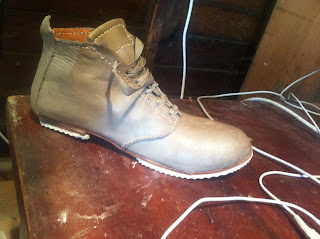I've been making lasts. Which is a cool and rewarding thing to do. A shoemaker just can't make a good pair of shoes without a good pair of lasts. I have made many lasts over the years. I do have a love of working with wood. And, so at times my shoe making shop is a wood working shop. Wood and leather have some characteristics that make them like cousins. Similar enough for it to make sense for a leather worker to be a wood worker.
Although I have many lasts already, I do have some pretty big gaps in my size stock. A shoemaker needs to have at least one pair of lasts for each size. So, the first stage in this project is to create a full set of lasts. These lasts are made from large pieces of dimensional doug fir. Some last makers will say that fir is too soft a material to use for this purpose. I have made lasts from Ash and Maple in the past. What I find is that given the proper maintenance and care fir lasts can live a long and useful life. The ease of working with fir to achieve the right shape allows for me to make a solid lasting last in a short amount of time. The overall savings of time and negligible difference in durability make it a wise choice and contributes to the efficiency of our handmade process.
So, large pieces of dimensional lumber are cut into blocks. Each block is about 13"X5"X4". I use some pretty simple geometry to identify several angles. These angles are used to cut lines with a miter saw. I cut four lines from the 'top' through to the 'bottom' of each block. I always leave a significant piece of the top and bottom flat so that they are parallel to each other for much of the shaping. This allows me to have a base from which to do geometry that maintains relativity to the other angles. Once the four lines have been cut from the top, measurements are made to determine where key features of the foot and last are to be placed. These important lines are ball, waist, and heel.
Using some relatively simple math, I find a few key ratios that have to do with widths and lengths. One of these ratios helps me to determine where the front of the ankle ends. From that point, I draw part of an ellipse that I then carve out. This arc defines the shape of the front of the shoe down to the toe. The fifth major cut is another arc that extends from middle of the heel to the waist of the foot. Once these five essential cuts have been made there is a fair amount of brute force shaping which I do with two of my favorite tools: The flexible draw knife and the spoke shave.
The spoke shave is an old tool that used to be used to shave down the wooden spokes of wagon wheels and chair legs. They are still an extremely useful tool.
The draw knife is not much different than the spoke shave outside of the fact that it is capable of removing a great deal of material very fast. This particular one is made of a flexible steel that allows some finesse in shaping.
Another key tool in this stage of the work is the Japanese Flush cut saw. It rapidly cuts through fir and gives nice straight cuts.
I will be editing and posting a time lapse film of me turning a block of fir into a last over the next few days.









































